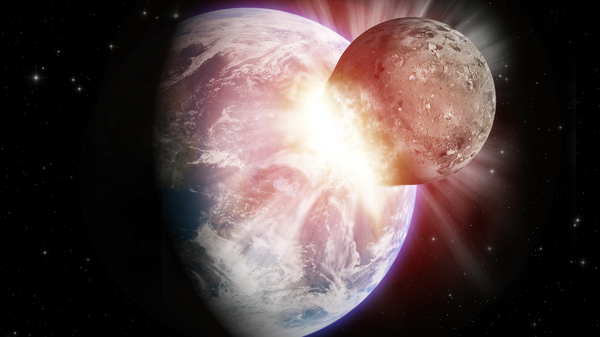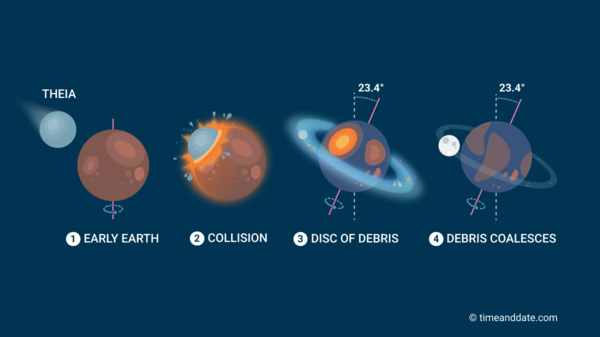How Was the Moon Formed?
Astronomers believe a massive body smashed into Earth 4.5 billion years ago, launching molten debris into orbit that fused to become our Moon.

A huge, high-temperature collision is thought to be the source of our planet´s satellite (artist illustration).
©iStockphoto.com/Ordus
Jan 2025: See the planets at their best
When Worlds Collided
Today, the most widely—accepted theory on the Moon's origin is the Giant Impact hypothesis, which holds that the Moon was formed from material hurled into space by this spectacular collision.
The object thought to have hit the Earth was a Mars—sized body known as Theia, named after the mother of the Moon goddess in Greek mythology.
More than the Moon
In fact, the fiery impact between early Earth and Theia may have created more than the Moon. Some researchers believe the material carried by Theia and the aftereffects of the cataclysm played a major role in creating the oceans, helping set the conditions for life to evolve on our planet.
Cosmic Mystery
But there is still much to be discovered about what exactly happened to form the Moon. Details of the collision are still being debated: How large was the object? How fast did it move through space? What was it really made of? Was there actually more than one impact?

The giant impact may have tilted the axis of early Earth and created the debris field that became the Moon.
©timeanddate.com
Massive Heat, Plumes of Molten Rock
It is estimated that this spectacular crash would have generated incredible heat — estimated by NASA to have been 100 million times hotter than the heat created by the asteroid impact that doomed the dinosaurs sixty—six million years ago.
The resulting inferno would have melted both proto—Earth and Theia, fusing the two into a single sphere, and spewing molten rock, dust and gasses into orbit. Some scientists think this created a rapidly—spinning disk of debris called a synestia, and that this material combined over time to create the Moon. Others have speculated that both the Earth and Moon formed out of this phenomenon at the same time.
Greater knowledge about the formation of the Moon could unlock important data about our home planet. “The more we learn about how the Moon came to be, the more we discover about the evolution of our own Earth,” said researcher Vincent Eke of Durham University in an interview with NASA. “Their histories are intertwined — and could be echoed in the stories of other planets changed by similar or very different collisions.”
What Apollo Tells Us
The Apollo missions brought back nearly 900 lbs (400 kg) of lunar rock, leading to analysis of the soil that has generally strengthened the Giant Impact theory, while raising some questions to be resolved.
Studies have shown Moon rocks have strong similarities with Earth´s geology, supporting the belief that the two bodies share a common origin. So some scientists are leaning towards the idea that Earth and Theia were made of similar materials, since they were formed somewhat near each other in the early solar system.
Another data point supporting the Impact theory is the fact that the Moon's orbit is centered near Earth's ecliptic plane, which is the path the sun travels through the sky. Researchers speculate that the material floating in orbit after impact would have consolidated around what was left of Theia´s core, which would have centered itself in this position.
There are differences between terrestrial and lunar geology, however. Apollo samples also showed that minerals on the Moon contain less water than Earth rocks, and there is a lack of potassium, zinc, and sodium. Some scientists believe these differences further support a collision origin for the Moon, because a high-temperature impact would have created a lot of fusing between the material of the colliding body and the Earth, making minor differences in the material thrown off by the impact. But these differences are not fully explained yet.
Capture, Co-formation, or Fission
While most scientists accept the Giant Impact hypothesis, there are other ideas about the Moon's origin, and there are uncertainties in the data. Some critics of the Giant Impact theory point out that computer models of the huge collision indicate that most Moon rock should be made up of material from Theia. But this hasn't proven to be the case.
So what are some other theories about the origin of the Moon?
One alternative scenario is the Capture theory, which posits that the Moon was a drifting celestial body captured by the Earth's gravity. This has happened in other places in our solar system, such as with the Martian moons of Phobos and Deimos.
While the Capture theory could account for the small differences in the isotopic composition of Earth and its Moon, it is pointed out that such satellites don't often form a spherical shape, and their paths usually don't follow the ecliptic of their parent planet.
Co-formation theory holds that Moons can form at the same time as their parent planet. According to this concept, gravity would have caused material in the early solar system to draw together simultaneously with the action of gravity-bound particles coming together to form the Earth and Moon on the same timeline.
Earlier in Moon research, an important idea was the Fission scenario, which speculated that the Earth spun so quickly at some point in history that material broke away and started to orbit the globe, which then combined to form the Moon. But this scenario has been largely disproved.